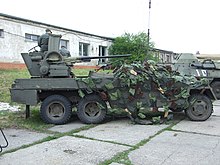Self-propelled anti-aircraft weapon
This article needs additional citations for verification. (August 2023) |
This article relies largely or entirely on a single source. (August 2023) |
An anti-aircraft vehicle, also known as a self-propelled anti-aircraft gun (SPAAG) or self-propelled air defense system (SPAD), is a mobile vehicle with a dedicated anti-aircraft capability.
Specific weapon systems used include
Anti-aircraft guns are usually mounted in a quickly-traversing turret with a high rate of elevation, for tracking fast-moving aircraft. They are often in dual or quadruple mounts, allowing a high rate of fire. In addition, most anti-aircraft guns can be used in a direct-fire role against surface targets to great effect. Today, surface-to-air missiles (generally mounted on similar turrets) have largely supplanted anti-aircraft guns, but they may return as a cheap way to counter unmanned aerial systems (drones), cruise missiles, and ultralight aircraft.
History
World War I
Anti-aircraft machine guns have long been mounted on trucks, and these were quite common during World War I. A predecessor of the WWII German "88" anti-aircraft gun, the WWI German 77 mm anti-aircraft gun, was truck-mounted and used to great effect against British tanks.
The British
Inter-war period
Between the two World Wars, the United Kingdom developed the Birch gun, a general-purpose artillery piece on an armoured tracked chassis capable of maintaining formation with their current tanks over terrain. The gun could be elevated for anti-aircraft use.

The first tracked SPAAG-design to be manufactured in series was most likely the British/Siamese Vickers Armstrong "Type 76" (per

The first modern SPAAG to be produced was most likely the Swedish
By the late 1930s, the British had developed a version of the
World War II
Larger guns followed on larger trucks, but these mountings generally required off-truck setup in order to unlimber the stabilizing legs these guns needed. One exception to this rule was the Italian Cannone da 90/53 which was highly effective when mounted on trucks, a fit known as the "autocannoni da 90/53". The 90/53 was a feared weapon, notably in the anti-tank role, but only a few hundred had been produced by the time of the armistice in 1943.
Other nations tended to work on truck chassis. Starting in 1941, the British developed the "en
The U.S. Army brought truck-towed Bofors 40 mm AA guns along with truck-mounted units fitted with mechanized turrets when they sailed, first for Great Britain and then onto France. The turrets carried four .50 inch (12.7 mm) machine guns, which were designed to be adjusted to converge at the single point where enemy aircraft were expected to appear at low altitude in conduction of strafing runs directed at large infantry and field artillery units.
Interest in mobile AA turned to heavier vehicles with the mass and stability needed to easily train weapons of all sizes. Probably the desire, particularly in German service, for anti-aircraft vehicles to be armoured for their own protection also assisted this trend.
The concept of using armored SPAAG (anti-aircraft tanks) en masse was pioneered by
The British developed their own SPAAGs throughout the war mounting multiple machine guns and light cannon on various tank and armoured car chassis and by 1943, the
Cold War and later


The introduction of jet engines and the subsequent rough doubling of aircraft speeds greatly reduced the effectiveness of the SPAAG against attack aircraft.[dubious
SPAAG development continued through the early 1950s with ever-larger guns, improving the range and allowing the engagement to take place at longer distances where the crossing angle was smaller and aiming was easier. Examples including the 40 mm U.S. M42 Duster and the 57 mm Soviet ZSU-57-2. However, both were essentially obsolete before they entered service, and found employment solely in the ground-support role. The M42 was introduced to the Vietnam War to counter an expected North Vietnamese air offensive, but when this failed to materialize it was used as an effective direct-fire weapon. The ZSU-57 found similar use in the Yugoslav Wars, where its high-angle fire was useful in the mountainous terrain.
By the late 1950s, the US Army had given up on the SPAAG concept, considering all gun-based weapons to be useless against modern aircraft. This belief was generally held by many forces, and the anti-aircraft role turned almost exclusively to missile systems. The Soviet Union remained an outlier, beginning the development of a new SPAAG in 1957, which emerged as the
The success of the ZSU-23 led to a resurgence of SPAAG development. This was also prompted by the introduction of
SPAAG development continues, with many modern examples often combining both guns and short-range missiles. Examples include the Soviet/Russian
Present day

Modern SPAAGs usually have short-range missiles for longer range engagement. The
Some examples of modern SPAAGs:
- Stryker M-SHORAD, US/Canada, 30 mm
- Skyranger 30, 30 mm
- Skyranger 35, Swiss/German, 35 mm
- Flakpanzer Gepard, Germany, 35 mm
- PGZ-09, China, 35 mm
- KORKUT, Turkey, 35 mm
- Luftvärnskanonvagn (lvkv) 9040, Sweden, 40 mm
- PASARS-16, Serbia, 40 mm
- K30 Biho, South Korea, 30 mm
See also
- 4M (artillery)
- Assault gun
- Flakpanzer, a collective term for German anti-aircraft tanks, particularly those used in World War II.
- List of anti-aircraft guns
- Man-portable air-defense system
- Self-propelled artillery
- Tank destroyer
References
- ISBN 9781472802347.


